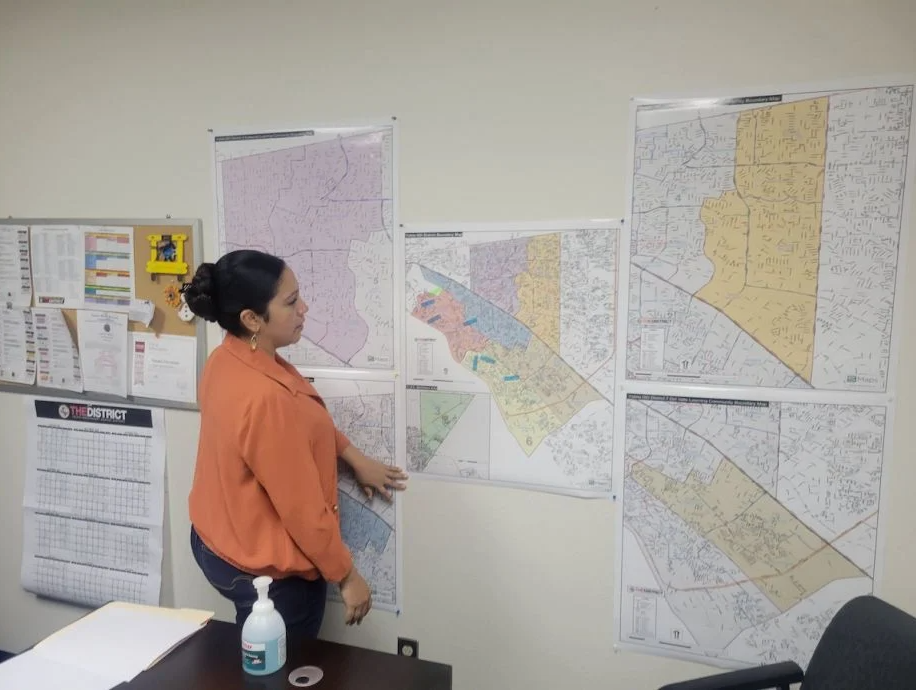Written by: Christian Betancourt
In 1939, bright yellow buses became the symbol for students traveling to school. Today, the buses alleviate traffic congestion while taking millions of children to school daily.
But most of them are powered by diesel, which harms the environment and could impact the health of the students riding them.
In cities across the U.S., school districts are beginning to change the vehicles they use to transport students.
In May 2022, the Environment Protection Agency earmarked $965 million for the Clean Bus Program that would be available for school districts nationwide for fleet electrification. In October, the EPA announced $50 million in funding for public schools in Texas to help 13 school districts purchase 144 electric buses.
“As many as 25 million children rely on the bus to get to school each day,” says EPA Administrator Michael S. Regan in a news release. “This is just the beginning of our work to build a healthier future, reduce climate pollution, and ensure the clean, breathable air that all our children deserve.”
The grants awarded were the first $1 billion of a five-year, $5 billion program that prioritizes low-income, rural and tribal communities.
Among them was the Socorro Independent School District (SISD) in El Paso. The Ysleta Independent School District (YISD) also applied for the grant. However, it was waitlisted along with the El Paso Independent School District in the EPA’s lottery process to select recipients. Anthony, Canutillo, Clint, San Eli, Fabens and Tornillo, the other six school districts in El Paso County were not located in the awarded or waitlisted records for the grant.
The EPA reported that it received 2,000 applications for $4 billion in funding, four times its budget of $965 million for the year.
“Because of the Bipartisan Infrastructure Law … Socorro ISD will be receiving a historic investment to modernize their bus fleet, significantly reduce greenhouse gas emissions, and limit exposure to harmful diesel emissions for our students, teachers, and staff,” says U.S. Rep. Veronica Escobar, D-El Paso.
SISD – which transports about 6,000 of its more than 48,000 students in 295 buses each school day – was awarded $9.8 million through the program for electric buses and infrastructure.
“About 30 percent of our fleet is nearing the end of its approved or approximated expected lifetime,” SISD Transportation Director Dexter Harman says. “Over the course of the years, we try to replace the buses as we go so that we don’t have a large expense impact all at once.”
Electric buses with a capacity of 71 to 77 passengers cost between $375,000 and $450,000, depending on their equipment. Non-electric buses cost about $125,000 to $165,000.
“Originally, when these buses were taking off, the cost was outrageous,” Harman says. “It had a lot to do with the batteries. But over the course of the past seven or eight years, there’s been a lot of developments and that cost has come down.”
Most districts must choose between investing in more diesel buses or the eco-friendly options. Harman says the grant allows SISD to experiment using the new technology without taking on a considerable expense.
“There’s very little risk as far as the initial investment that the district’s going to have to go out for,” he says. “The grant covered over 90 percent of the initial cost of the buses. We thought it’d be good to go ahead and take up an opportunity like this.”
SISD needs to replace 55 buses. The grant will cover the cost of 25 electric buses and charging infrastructure of up to $20,000 per bus replaced, which could be available in the district as soon as January 2024. The grant program includes specific eligibility criteria for buses to be replaced. For example, the diesel-powered school bus must be planned to “be scrapped if selected for funding” and its model year must be 2010 or older, according to the program guide.
Based on those requirements, “we were only able to replace 25,” Harman says. “They weren’t necessarily buses that were that old. It’s just there were certain engine lines and types of diesel buses that had to meet the criteria. The grant will not replace our current need.”
YISD has a fleet of 216 buses that carry about 10,000 of its 36,127 students. About 30 percent of those buses need to be replaced. When YISD Director of Transportation Rosario Fernadez heard they were not selected, she learned if some of those chosen became ineligible or did not want to take the grant, the waitlisted districts would be contacted.

“We have not heard back from [the EPA],” Fernandez says.
The approval of the grant would allow the district to purchase buses it might not initially consider purchasing within its budget.
Fernandez says that based on the condition of the district’s fleet, it would make more sense to purchase two buses instead of only one.
“We want to go greener and have a more sustainable future, but at the same time, we also have to outweigh the cost in terms of what are our needs within the district,” she says.
Each year, districts re-examine the need for bus replacement and make recommendations to their board of trustees as the budget for the school year is revisited, says SISD Assistant Superintendent Andre Cruz.
Harman says SISD replaces its buses based on priority.
“One year you might not replace any. Maybe in the third year of year three, you might have to replace 20 of them,” he says.
The environmental benefits for the students, along with the reduced cost of fuel and maintenance, were added benefits, Harman says.
“Your fuel is gonna be the cost to actually charge the buses,” says Harman, noting that it costs 80 to 90 cents per mile to fuel a diesel bus while charging an electric one costs 15 cents to 25 cents per mile.
“We do anticipate major savings in the first year, having those 25 buses on routes,” he adds. “Over the course of the next couple of years, maybe then we can make a more permanent decision whether we’re going to pursue going with electric or staying with the diesel.”
Some benefits of an electric bus fleet for Fernandez are fewer emissions, low maintenance, and noise reduction. At the same time, she recognizes that major repairs of an electric bus can be costly.
“Better air quality also results in improved health for anybody and everybody,” she says. “You’re looking at savings in fuel and then oils. I think, on the flip end, batteries are pretty expensive. I think it was a pack of six to eight, and they don’t sell individual batteries. It’s about half of the cost of the bus.”
In the U.S., no school district is under any obligation or mandate to go green by a specified time period. However, this may change as more and more local, state and federal entities push for cleaner transportation efforts.
“I do see that there’s gonna be a bigger push after this,” Harman says. “There’s going to be more available grant monies over the course of the next four years. With that in mind, we’re going to closely monitor. I think at that point we’ll make a recommendation if it’s feasible to go ahead and continue with the investment in electric.”
When electric school buses first came to market, the exorbitant cost made it unfathomable for schools to consider. As the technology develops and more options are available, transitioning to an electric school bus fleet is becoming more feasible
“I would definitely like to see that in the future electric buses get to a point where prices are reasonable and districts are able to decide whether it’s more efficient to purchase an electric bus than alternative fuels,” she says.
The fleet at YISD has more special education routes that comprise about 30 percent of the total ridership with general education encompassing the remaining 70 percent.
“For this school year 22-23, we started with 59 general education bus routes and 67 special education bus routes,” Fernandez says. “The general education program costs us more to operate than the special education program. It almost seems that [the special education] population is increasing and so it requires the smaller units with the wheelchair lift equipped or certain types of safety equipment that we need to make sure that they’re installed with.”
Public Transport Grants
In August 2022, Sun Metro, the public transportation entity in the city of El Paso, received $8.8 million from the Federal Transit Administration (FTA) to invest in electric buses. The entity was selected from more than 500 public transit agencies in the U.S. in FTA’s first competitive grant as part of the Bipartisan Infrastructure law. The total grant amount was $1.66 billion for the 2022 fiscal year. The entity reported that 530 eligible proposals were submitted, totaling approximately 7.72 billion in requests.

“These federal dollars for Sun Metro will make a profound difference in the lives of our customers who rely on paratransit services and who are presently served by an aging fleet,” says Ellen Smyth, the city’s Chief Transit and Field Operations Officer, in a news release.
The city of El Paso matched $2.2 million for a total project cost of about $11 million. The project entails the purchase of 50 zero-emission paratransit vehicles, installing 25 electric charging stations, and hiring and training existing employees in the new technology.
Officials with Sun Metro have yet to respond to various inquiries about the project’s status and other questions.
“When a transit door opens, whether it is a bus, train, or ferry, it is a great equalizer for everyone in our nation,” says FTA Administrator Nuria Fernandez. “These investments also help us meet our goals of cutting transportation emissions, creating good-paying American manufacturing jobs, and helping America’s transit workers prepare for new vehicle technology.”
This story was co-published with El Paso Matters as part of Next City’s joint Equitable Cities Reporting Fellowship For Borderland Narratives.

This story originally appeared in Next City and is part of Covering Climate Now, a global journalism collaboration strengthening coverage of the climate story.







